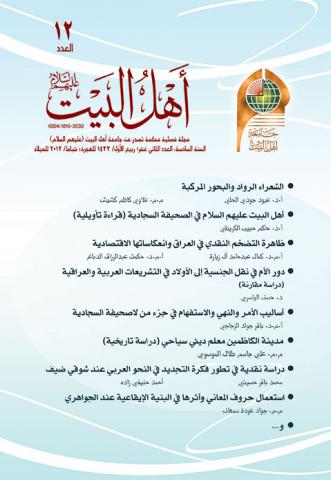Abstract
**Summary**
Arabic poetry emerged from rhythmic patterns rooted in the richness of the Arabic language, which is abundant in rhetorical and structural features. These rhythmic patterns are categorized into two types of poetic meters:
1. **Pure Meters**: Their feet (tafeet) are uniform, such as (Rajaz, Ramal, Hazaj, Kamil, Mutaqarib, Mutadarak).
2. **Compound Meters**: Their feet vary, such as (Taweel, Baseet, Madeed, Munserih, Khafeef, Saree’, Wafer, Mujtath, Muqtadab, Mudari’).
Some meters were more prevalent than others, with Taweel and Baseet dominating classical Arabic poetry. With the rise of free verse poetry, pioneer poets leaned towards pure meters to break away from the monotony of traditional two-hemistich poems and to modernize the poetic line. They relied on a single recurring foot while maintaining rhyme and the unity of the final foot (Darb).
Later, some modernist poets, notably Badr Shakir Al-Sayyab, attempted to incorporate compound meters into free verse poetry. Although these efforts were relatively rare, they represented a bold endeavor that strengthened the connection between modern poetry and classical Arabic poetry. This experimentation also highlighted the untapped rhythmic potential of the Arabic language, blending tradition with innovation.
Arabic poetry emerged from rhythmic patterns rooted in the richness of the Arabic language, which is abundant in rhetorical and structural features. These rhythmic patterns are categorized into two types of poetic meters:
1. **Pure Meters**: Their feet (tafeet) are uniform, such as (Rajaz, Ramal, Hazaj, Kamil, Mutaqarib, Mutadarak).
2. **Compound Meters**: Their feet vary, such as (Taweel, Baseet, Madeed, Munserih, Khafeef, Saree’, Wafer, Mujtath, Muqtadab, Mudari’).
Some meters were more prevalent than others, with Taweel and Baseet dominating classical Arabic poetry. With the rise of free verse poetry, pioneer poets leaned towards pure meters to break away from the monotony of traditional two-hemistich poems and to modernize the poetic line. They relied on a single recurring foot while maintaining rhyme and the unity of the final foot (Darb).
Later, some modernist poets, notably Badr Shakir Al-Sayyab, attempted to incorporate compound meters into free verse poetry. Although these efforts were relatively rare, they represented a bold endeavor that strengthened the connection between modern poetry and classical Arabic poetry. This experimentation also highlighted the untapped rhythmic potential of the Arabic language, blending tradition with innovation.
Keywords
compound meters
Free Verse
poetic rhythm
pure meters
taf’eela
Abstract
نشأ الشعر العربي على أوزان مستمدة من ثراء اللغة العربية وخصائصها البنائية، وانقسمت هذه الأوزان إلى نوعين من البحور:
البحور الصافية: تتشابه تفعيلاتها مثل (الرجز، الرمل، الهزج، الكامل، المتقارب، المتدارك).
البحور المركبة: تتنوع تفعيلاتها مثل (الطويل، البسيط، المديد، المنسرح، الخفيف، السريع، الوافر، المجتث، المقتضب، المضارع).
سادت بعض البحور أكثر من غيرها، وكان للطويل والبسيط الحضور الأبرز في الشعر العربي التقليدي. ومع ظهور حركة الشعر الحر، اتجه الشعراء الرواد إلى البحور الصافية لتجنب الرتابة وتجديد بنية السطر الشعري، مع الحفاظ على القافية ووحدة (الضرب).
فيما بعد، حاول بعض الشعراء الحداثيين، وعلى رأسهم بدر شاكر السياب، تطويع البحور المركبة لشعر التفعيلة، رغم أن هذه المحاولات بقيت محدودة. لكن هذه التجربة مثلت مغامرة جريئة عززت ارتباط الشعر الحديث بأصالة القصيدة العربية، واستثمرت الإمكانيات الإيقاعية الغنية للغة العربية في إطار جديد من الإبداع والتحديث.
البحور الصافية: تتشابه تفعيلاتها مثل (الرجز، الرمل، الهزج، الكامل، المتقارب، المتدارك).
البحور المركبة: تتنوع تفعيلاتها مثل (الطويل، البسيط، المديد، المنسرح، الخفيف، السريع، الوافر، المجتث، المقتضب، المضارع).
سادت بعض البحور أكثر من غيرها، وكان للطويل والبسيط الحضور الأبرز في الشعر العربي التقليدي. ومع ظهور حركة الشعر الحر، اتجه الشعراء الرواد إلى البحور الصافية لتجنب الرتابة وتجديد بنية السطر الشعري، مع الحفاظ على القافية ووحدة (الضرب).
فيما بعد، حاول بعض الشعراء الحداثيين، وعلى رأسهم بدر شاكر السياب، تطويع البحور المركبة لشعر التفعيلة، رغم أن هذه المحاولات بقيت محدودة. لكن هذه التجربة مثلت مغامرة جريئة عززت ارتباط الشعر الحديث بأصالة القصيدة العربية، واستثمرت الإمكانيات الإيقاعية الغنية للغة العربية في إطار جديد من الإبداع والتحديث.
Keywords
البحور الصافية، البحور المركبة، الشعر الحر، التفعيلة، الإيقاع الشعري
